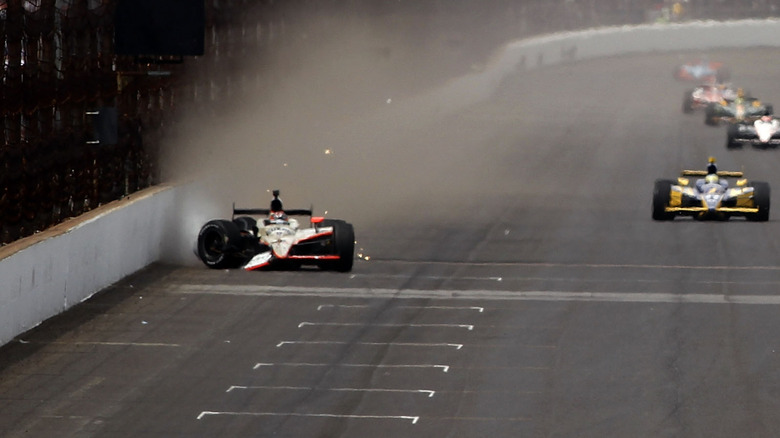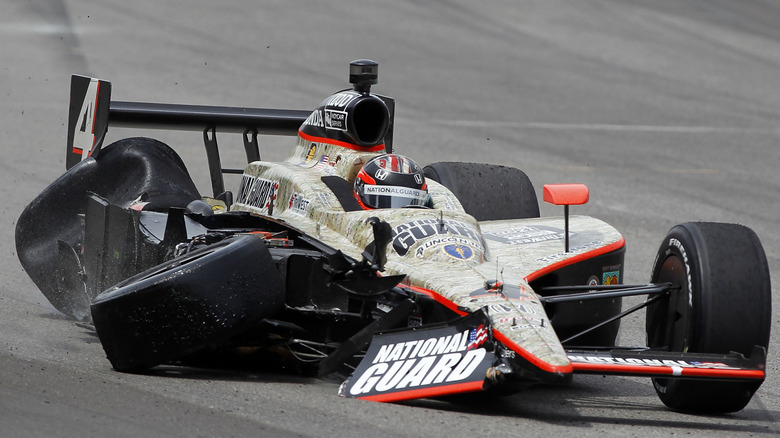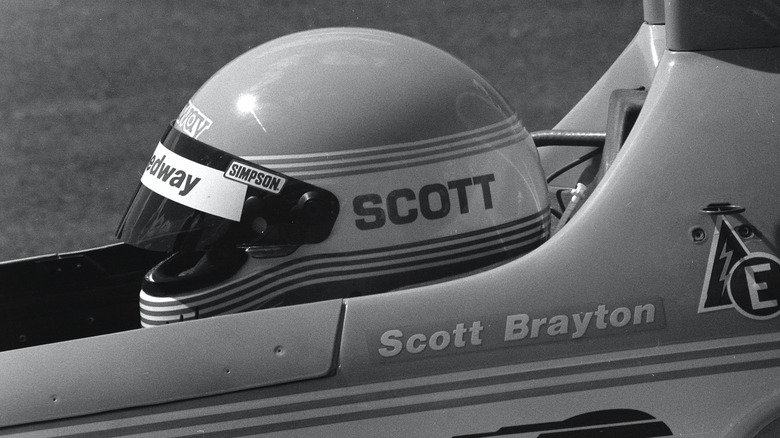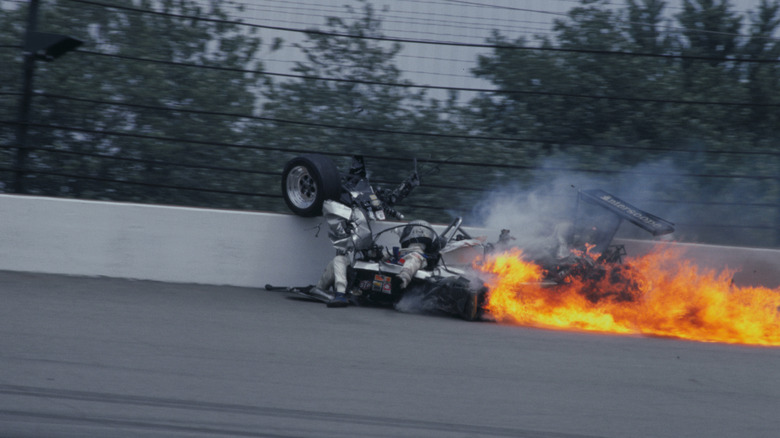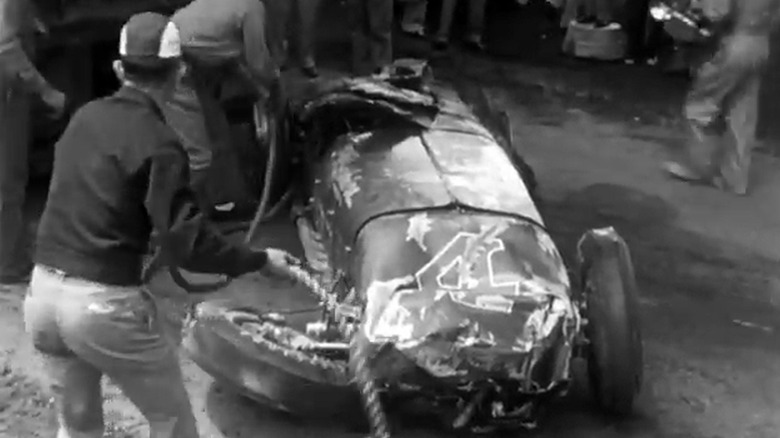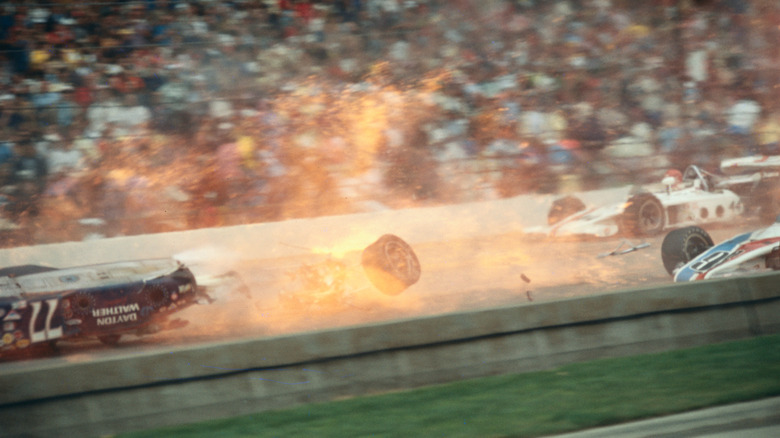5 Of The Worst Indy 500 Crashes Of All Time
The Indianapolis 500, hosted yearly at the infamous Brickyard Indianapolis Motor Speedway, boasts one of the highest average speeds in all of motorsports. These days, a qualifying lap at Indy can exceed 230 mph, almost triple the speeds of some of the earliest races. While we've unquestionably come a long way in terms of safety equipment, it remains an incredibly dangerous sport and crashes occur somewhat often.
Of course, not all these crashes are serious — though it's tough to have a non-serious accident at over 200 mph. On the other end of that spectrum, however, sits some of the most spectacular and devastating motorsports crashes across the board, thanks in no small part to the savage speeds an IndyCar is capable of achieving. For the most part, every year has at least one minor or major accident at some point during the event. Some accidents are caused during practice sessions when cars aren't fully dialed in yet, others in qualifying when drivers are pushing as hard as possible. Then, of course, there are crashes on Race Day, frequently among the more destructive thanks to the plethora of cars and spectators.
This list will categorize the worst among them as those which most deeply affected subsequent races, or were among the most historically destructive events. As a forewarning, we will discuss motorsports-related deaths and similar tragedies. Sadly, at the speeds these vehicles can achieve, survival is by no means a guarantee, especially when surrounded by similarly-fast cars. That said, let's explore some of the most impactful accidents in the history of the Indianapolis 500.
2011 and the stunning final-lap upset of JR Hildebrand
Imagine being a rookie driver in one of the biggest races of all time, the Indianapolis 500, a race that's 200 laps long totaling 800 left-hand turns. However, that first time out, you found yourself in the lead of the race with your radioman shouting that you're "gonna win it!" as you round the last turn. You performed 799 turns flawlessly, but on turn 800 of the Indianapolis Motor Speedway, also known as the Brickyard, everything ended in a split second. It sounds like a fairytale-esque nightmare scenario, but that turned into a shocking reality for JR Hildebrand in what was one of the most iconic and terrible upsets in motorsports history.
This crash wasn't the worst in the sense that it was the most physically-destructive, nor caused the biggest pileup. Rather, it's among the worst in terms of the sheer impact it left as one of the most incredulous moments in all of sports. Rarely do you have a rookie with the talent to go the distance in a sport as technically and physically-demanding as auto racing, lesser-still a rookie with race-winning pace. However, as they say, "It ain't over 'till it's over."
While the crash cost JR Hildebrand the overall win, he actually managed to drag his mangled vehicle across the line in second. The winning car was piloted by Dan Wheldon, though it unfortunately became his last ever win at Indy. Five months later, Wheldon was tragically killed in a 15-car wreck in an IndyCar race at Las Vegas.
1996 and the death of Scott Brayton
Scott Brayton was the classic skilled racer whose life was tragically cut short. He'd actually held the record at Indy for the fastest average speed at the time — 214.199 mph in 1985, as well as the fastest unofficial average speed recorded at 237.555 mph.
Moreover, he had raced open-wheel for over a decade, with seat-time in both CART and IndyCar. Like how IndyCar and Formula 1 differ significantly, so do CART and IndyCar, though both series use open-wheeled vehicles. By any measure, this was a man who loved what he did and was exceptional at it. Sadly, the Brickyard can be an unforgiving circuit.
The accident didn't occur during a race, however; it happened earlier on a practice session. Brayton was negotiating Turn 2 at around 230 mph, when he suffered a catastrophic tire blowout on the right rear, spinning the car and sending it into the barricade rear-first with tremendous force. The car skidded to a halt some distance away, with Brayton critically injured. He tragically passed away 37 minutes later.
News outlets reported that this accident was actually caused by particulates on the road surface, which punctured the tire and caused a blowout, leading to a loss of traction. At speeds in excess of 200 mph, punctures are universally catastrophic, especially while negotiating a corner. While Brayton never won an Indy 500 race, he was nonetheless a recognized as a highly-accomplished driver. Today, the Kruse Automotive and Carriage Museum, about an hour from Brayton's Michigan hometown of Coldwater, hosts an exhibit dedicated in Brayton's honor.
1981 and the near-fatal incidents of Rick Mears and Danny Ongais
This marked one of the most volatile times in all of the Indianapolis 500's history, thanks largely to a pair of horrific incidents which occurred in the same race: A pit fire engulfing Rick Mears and staff in invisible flames, and a horrific accident out of turn 3 for Danny Ongais.
Unlike Ongais, Mears' accident involved no high-speed collisions. Rather, it was due to an alarming property of the fuel racing teams used at Indianapolis: methanol. Unlike gasoline, methanol burns invisibly, meaning the flames are nearly impossible to see. As a result, the fire caused by a fuelling malfunction in the pits threatened to consume Mears and several mechanics, who all frantically waved for emergency personnel because no one could visibly see the inferno in the pit lane.
The volatile nature of this fuel similarly nearly cost Danny Ongais his life, when he crashed into the Turn 3 wall and skidded along the circuit at around 200 mph. His car was effectively belt-sanded by the wall, leaving nothing but half of a chassis and his legs dangling out of the front in a truly heartbreaking scene as ambulances rushed to his aid. His car similarly burst into flames, though the quick actions of the first-responders ultimately saved his life.
Thankfully, this year had no fatalities, though it hosted many injuries, including track staff, two drivers, and several spectators struck by debris from Ongais' accident. However, the nature of the Rick Mears fire highlighted the unique hazard posed by racing methanol; this fuel was phased out in 2006 for less-volatile ethanol. However, methanol is still commonly used as a fuel additive in racing fuels for disciplines like drag racing.
1955 and The death of Bill Vukovich
1955 is likely the darkest year in the history of motorsports, a year people generally remember due to one specific event: the 1955 Le Mans disaster which resulted in the deaths of over eighty people, one of the defining moments of the famous endurance race. However, that wasn't the only time tragedy struck the motorsports community that year.
On May 30, 1955, Bill Vukovich charged for his third Indy 500 victory, having set the fastest lap at a 1:03.67. He was, by all accounts, an exceptionally fast and skilled racer, holding both the 1953 and 1954 wins behind the wheel of his Fuel Injection Special by the time he took to the circuit in 1955. He was also the head of one of the most prominent names in the sport, with his son following in his footsteps and claiming Rookie of the Year in 1968.
Sadly, while unquestionably talented, the Indianapolis Motor Speedway claimed his life. The accident occurred out of Turn 2 on lap 53; two other drivers, Rodger Ward and Al Keller, came together after Ward's car hit the wall. Keller frantically hit the handbrake; Vukovich came out of the blind corner and struck the obstacle, sending his car tumbling. It cleared the roadside barrier and entered the wooded area beside the circuit before erupting into flames, with Vukovich killed almost instantly.
This crash, along with the Le Mans tragedy which happened shortly thereafter, called into question the morality of automobile racing, leading to the near-banning of the sport as a whole and demands for significant safety reforms across the board.
1973 and Indianapolis 500's darkest hour
Without argument, the most tragic event held at Indianapolis Motor Speedway occurred in 1973. The race and its preceding events claimed no fewer than three lives, including two drivers: Art Pollard and David Earl Savage, Jr., as well as mechanic Armando Teran.
Pollard's death occurred first during a practice run, when he lost control of his Eagle at over 190 miles per hour and slammed into the inside wall. His car erupted into flames and flipped several times in the infield, shattering Pollard's spine. He tragically died later that day in the hospital.
As if that wasn't horrible enough, the race itself hosted two consecutive fatal accidents in just as many minutes. David "Swede" Savage came out of the final corner and lost control going too low on the course, sending his car straight into the inside wall at full speed. His car split in half, disintegrating on impact as the mangled wreck came back onto the circuit.
With a near-full tank, the resulting inferno engulfed massive swathes of the track and burning over a dozen spectators, with fire marshals rushing onto the scene. One of the fire engines ran the wrong way down the pit lane to get to the fire quicker; in a truly heartbreaking moment of panic, it struck mechanic Armando Teran and sent him 50 feet down the road. Both individuals survived the initial impacts, though later they ultimately succumbed to their respective injuries.
This devastating moment led to numerous reforms, including smaller fuel cells, turbo boost limiters, and various safety features in the hopes that such a tragedy may not occur again. As power increased and IndyCars became some of the most powerful racecars ever, such features became mandatory, and many started here.
